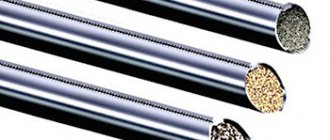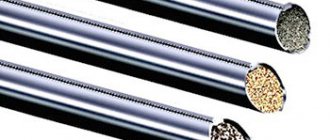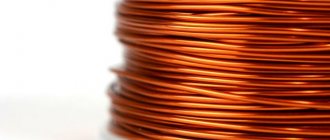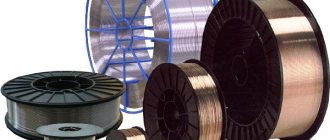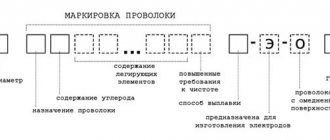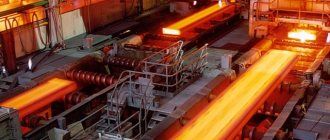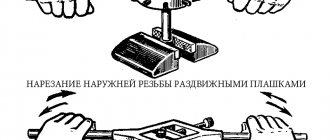Welding or filler wire is supplied in reels. This is convenient for industrial lines: the reel is installed on the feeder and the rod is automatically sent to the welding zone. An alternative is manual material feeding, which is common outside of mass production.
The filler rod itself can be different: solid, hollow or with special inclusions. The metals from which it is made also have a wide range: aluminum, brass and others. When choosing this parameter, welders pay attention first of all: the composition of the additive must be identical to the metals being welded.
Types of welding wire
When carrying out welding work, the following types of wire are used:
- powder _ In demand when working with carbon steel, which will subsequently be subject to heat treatment;
- aluminum _ It is used when welding workpieces made of the same material. The content of silicon, manganese, magnesium and other inclusions is allowed);
- stainless steel Suitable for working with stainless metals: steel containing chromium or nickel;
- copper-plated - for working with high and medium alloy steel;
- steel _ Designed for welding medium and low alloy steel.
By purpose
Welding wire is classified according to a number of parameters, the main ones being structural features, chemical composition, and specific use.
According to purpose, it is divided into products of general and special use. The first is used when welding all grades of steel (the letters Sv are present in the marking), as well as in surfacing (Np). The second is used when welding special alloys, cast iron, when performing welding work under water, as well as when welding with forced formation of a seam.
In the second case, the chemical composition of the filler material is, as a rule, completely identical to the composition of the base metal.
Wire for stainless steel
This filler material is used in cases where steel containing chromium or nickel is welded in an inert environment. Main advantages:
- the result is a high quality seam;
- there are no cracks on the surface of the welded joint;
- the seam is resistant to corrosion;
- a small amount of splashes;
- arc stability.
Stainless steel welding wire has an important advantage: it creates a weld with an increased service life. It is made from high-alloy steel, in which the content of nickel, chromium and other similar inclusions is high. They minimize the likelihood of rust formation or the onset of corrosion processes.
Wire can be solid or cored. The first is used for working in an inert environment or submerged arc. Shielding gases are necessary to prevent the penetration of atmospheric oxygen, which could oxidize the stainless steel during the thermal joining process. Of course, this will negatively affect the quality of the weld.
Powder consumables are a thin-walled tube into which flux and additional elements for gas formation are poured. Their advantage is that an inert environment is not required. I form the protective shell with such filler materials myself. They are usually called self-protective.
During operation, the consumable passes through the current-carrying tip. Because of this, its diameter may decrease slightly, which ultimately reduces the quality of the welded joint. Therefore, wire is usually divided into normal and high-precision. The diameter varies over a wide range of values: from 0.13 to 6 millimeters. The key parameter influencing the choice of filler wire for welding stainless steel workpieces is the matching of the material of the parts and consumables.
Activated
Inside the activated welding wire there is a small amount of powders, which are pressed in the center and look like wicks. This type of filler material is used to work in pure carbon dioxide or its mixture with other gaseous substances.
The activation function is performed by carbonates of alkali metals and barium; oxides of titanium, silicon, magnesium; calcium fluoride. As a result, the welding arc burns stably, and a high-quality seam is formed without metal spattering.
Copper-clad wire
The material has the same set of advantages as wire for welding stainless steel. Plus, it also helps reduce tip consumption, regardless of the brand of welding machine. The main purpose is to join high-alloy and carbon steels in a protected environment.
The consumable is supplied to the consumer market wound on a plastic cassette. Thanks to ease of use, the productivity of specialists increases. The standard thickness of copper-plated wire is 0.6; 0.8 and 1 mm. It simplifies the re-ignition of the welding arc and maintains the stability of its combustion in different modes.
A classic example of such a consumable material is SV-08G2S wire, which contains 1% silicon, 2% manganese and 0.8% carbon. Another option is esab brand welding wire, designed to work with a wide range of steels, including tool, marine, stamped; stainless steel, aluminum and even cast iron.
For argon welding
For argon arc welding, uncoated wire is used . The bath is protected by gas. Composition of consumables: steel of varying degrees of alloying, aluminum, nickel alloys. In semi-automatic TIG machines, the wire acts as an electrode. It is fed through a holder and an arc is formed at its end.
When welding long seams and calculating the cost of work, the consumption of welding wire per 1 meter of seam is indicated by the table on the packaging. It shows several gap sizes and part thicknesses and indicates how much material will be needed. Consumption can be indicated in weight and additionally in length.
For a preliminary calculation, you can use a wire calculator . You should fill out the columns indicating the material of the rod, its diameter, and its brand. The consumption also includes technological waste. An accurate calculation will be made by a calculator that takes into account the length of the seam.
Steel wire
It is used in most areas of human production activity. It is characterized by a large number of indicators, the main of which are the cross-sectional diameter, strength and composition of the material used in manufacturing. There are many types of steel wire: reinforced, spring welding, barbed and others. The marking of the material intended for welding contains the abbreviation “St”. Available in different diameters: from 0.3 mm to 12 mm.
There are more than fifty different brands of products, which can be divided into three groups:
- For steel with low carbon content. As an example: Sv-10G2, Sv-08, Sv-YUGL.
- For welding low and medium alloyed workpieces. Wire brands Sv-08G2S, Sv-18HS, Sv-08GS and others are suitable.
- For connecting structures made of high-alloy steel: Sv-12Х13, Sv-08Х14GNT.
In some cases, the surface of the steel wire is coated with a thin layer of copper. This is done to protect the metal from oxidation and improve its electrical conductivity.
Steel wire is used when working with inert gases or submerged arcs. This is the consumable material most suitable for argon welding. Chromium, manganese, nickel, titanium, tungsten or molybdenum are used as alloying elements in manufacturing. Thanks to the first three components, it is possible to join stainless steel with a high carbon content.
Main varieties
The main characteristics by which products are divided are:
Cross-sectional size and shape; Type of final processing; Surface type; Chemical composition of steel; Application area. Products are divided into groups based on thickness. Products of the first group are the thinnest, their thickness is less than 0.1 mm. The ninth group includes products whose cross-sectional size is more than 8 mm. Products according to GOST are manufactured in round, square, multi-faceted and shaped profiles.
The final treatment provides the required mechanical properties. To strengthen the mechanical strength and durability, the products are thermally treated: hardened, annealed and stabilized.
Based on the type of surface, products are divided into coated, unfinished and finished. Zinc, copper, aluminum and brass are used as steel coatings. For finishing, the surface is ground, polished or etched.
Types by purpose and area of application:
General purpose; For the production of meshes; For reinforcing reinforced concrete structures; Ropeway; Welding; String; Spring; Structural; For air communications; For wires and cables; Linking; Printing; Needle room.
Depending on the purpose and required performance characteristics, products are made from steel of various types and grades. General purpose products, as well as binding products and those used for reinforcing reinforced concrete products, are made from low-carbon steel. For the production of springs, wire cores, spokes and ropes, carbon, alloy and high-alloy steels are used. For some structural types, special requirements are put forward for steel in terms of the content of carbon, chromium, nickel and other chemical elements.
Aluminum wire
Used when working with aluminum alloys in which the silicon content does not exceed 3%, and copper - from 3 to 5%. Products manufactured for semi-automatic welding machines are made of aluminum, which has a positive effect on seam formation:
- gives additional strength;
- exactly matches the color of the blanks;
- has the same corrosion resistance as any other aluminum alloy.
Most often used in automotive production and shipbuilding. In third place in demand are organizations where welded structures interact with water. Characterized by excellent ductility and low weight; Most often used in gas welding. Suitable for joining other non-ferrous metals.
In practice, there are no metal parts or structures that consist of pure aluminum. Additional inclusions are always used to improve certain characteristics. This statement is also true for the welding wire itself, although often the amount of additives is measured to not exceed one percent. For example, only 0.2% titanium allows a specialist to make a fine-grained seam, which is extremely necessary when performing precision work.
However, according to GOST, pure aluminum wire is defined as a separate category. In addition to it, there are alloys with magnesium, copper or silicon. In addition to the provisions of the state standard, there are technical conditions that regulate the production of other alloys: with chromium, as well as with silicon and magnesium.
An important condition for a high-quality connection is the correspondence of the composition of the workpieces and the consumable material. Only magnesium, which actively evaporates at high temperatures, can be considered as an exception. Its composition in the additive can be 10-20% greater than the nominal value.
Flaws
Welding is carried out at low speed. The thickness of the parts is limited . The iron sheet should not exceed 10mm.
The gas cylinder creates inconvenience in work. It has to be constantly moved and replaced. For safety reasons, it should be located at a distance from the welding machine. It is difficult to work with in tight spaces. The cost of inert gases is significantly higher than carbon dioxide.
Flux Cored Welding Wire
Flux-cored welding wire is in demand when working with carbon, medium-carbon and low-alloy steel. For a high-quality result, the absence of a gaseous environment is important. This wire is also called fleece wire. This is due to the fact that the additive is not completely metal, but is filled inside with powder - fleece. Its content is approximately 15-40 percent of the total mass. The property of the material depends on the specific value.
The main advantage of the consumable is the high quality of the welded joint, ease of slag removal, and a highly stable electric arc during the welding process. Depending on the characteristics of the filler, it is customary to divide cored wire into five groups:
- rutile-fluorite. Designed for low alloy steel;
- organic rutile perfectly connects low-carbon metals;
- rutile is designed for steel with a medium amount of carbon;
- fluorite-carbonate is used when working with low-alloy and low-carbon metals, which are used in the creation of critical structures;
- fluorite is an intermediate link between the previous type of wire and rutile-fluorite.
Quite often, flux-cored wire is confused with steel. For example, some manufacturers call the esab brand steel, while others call it powder. This situation misleads buyers. It would be fair to separate flux additives into a separate group. And this would be fair, since flux greatly increases the capabilities of a semi-automatic device. And another very important advantage is that the powder consumable is the key to a higher quality welded joint compared to conventional metal wire.
The strength of the weld largely depends on the correct choice of consumables. Experienced welders often recommend that beginners opt for universal materials. And this recommendation is quite fair, but not always. For example, without inert gases the result will be mediocre.
Welding wire marking
To choose the right additive, you need to know in advance what type of work you plan to perform. The fact is that each type of wire is designed for a specific job. Cutting metal is unlikely to be possible with consumables designed for semi-automatic welding.
Plus, the consumables differ in diameter, which is selected depending on the thickness of the workpiece. The thicker the parts being welded, the larger the diameter of the additive should be. And it varies over a wide range of values: from 0.8 to 12 mm. Most often, welders require relatively thin rods - about 3 millimeters.
When planning to weld two titanium workpieces, it is logical to assume that a specialist uses the appropriate titanium welding wire. It is important to know its composition. After all, various additives are often added to the wire; The level of alloying also varies. The quality of the weld depends on the compatibility of the base material and the additive. The more homogeneous their composition, the better for the final result.
All information is “hardwired” into the labeling. To determine what a particular symbol means, it is enough to consider a simple example. The abbreviation “Sv-06Х19Н9Т” denotes one of the most popular types of additive. The first two letters “Св” indicate that the material is intended only for welding - cutting or other types of work cannot be performed with it. That is, the first two letters indicate the type of consumable. In addition to welding wire, there are surfacing wires (“Np”) and flux-cored wires (“Pp”).
The next two numbers indicate the percentage of carbon. 06 is six hundredths of a percent (0.06%) of the total mass of the material. Below is information about the inclusions and their shares. The letter “X” informs that the additive contains chromium, and its amount is “19” - 19%. The additive contains 9% nickel (“N”), but how much titanium (“T”) is not indicated. The fact is that if the amount of inclusion is less than 1%, then such data is not included in the labeling. That is, there is less than one percent titanium in the wire.
It remains to remember what certain symbols mean that are used in wire markings:
- G – manganese;
- D – copper;
- M – molybdenum;
- C – silicon;
- C – zirconium;
- F – vanadium;
- Yu – aluminum.


